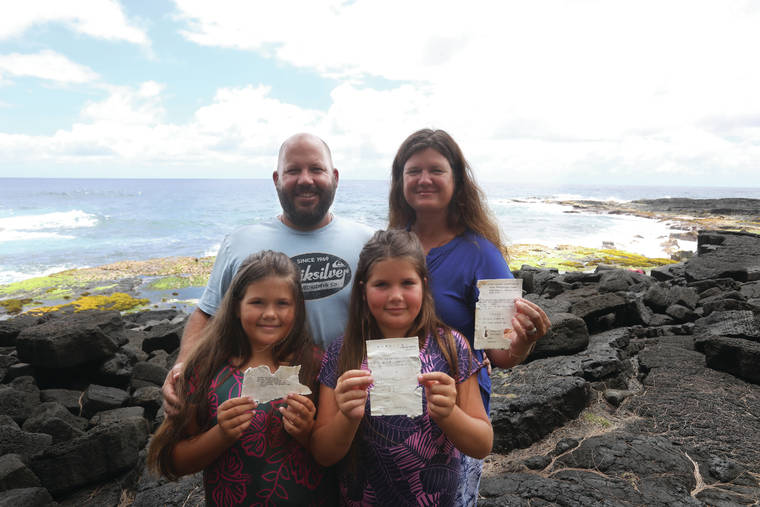With the Father’s Day discovery of a message in a bottle at the Makuu Drive shoreline in Hawaiian Paradise Park, Abbie Graham became a part of something bigger than she imagined.
The find by the 9-year-old Keaau girl — first reported by the Tribune-Herald on July 14 — was the 51st bottle found out of 750 released in 1984 and 1985 as part of an investigation of ocean currents by the Natural Science Club at Chiba Prefectural Choshi High School in Choshi, Japan. It was also the first bottle found in more than 19 years and only the second this millennium.
The previous discovery was on Jan. 7, 2002, at Kikaijima Island in Kagoshima Prefecture in southeastern Japan.
“We are very happy and excited by this discovery,” said Jun Hayashi, vice principal of Choshi High School, who was the faculty advisor for the school’s Natural Science Club from 2000 to 2004. “At present, we no longer have a Natural Science Club at the school so there are very few people who know about this project on ocean currents.”
Hayashi said he relayed news of the girl’s discovery to Yutaka Michida, a professor at the University of Tokyo’s Atmosphere and Ocean Research Institute, whom Hayashi described as “one of the foremost authorities in the field of ocean currents.” He said Michida was “very interested” in the find.
According to Hayashi, Michida told him a buoy released off the coast of Japan was floated by the North Pacific subtropical gyre, a large system of rotating ocean currents, “nearly reached the place where this bottle was found.”
“It is possible that the bottle was also floated by the same current,” Hayashi said. “Nowadays, because of environmental concerns, such currents are studied by using GPS buoys. Thus, we cannot do this type of survey at our school.”
John Graham, the father of Abbie and her 10-year-old sister, Aubrie, said in an email to Hayashi his daughters “are very excited about the study and amazed that a bottle could travel all this way.” The bottle she found on the June 20 family outing was one of 450 released in 1984.
As it turns out, Abbie Graham’s find is the 10th bottle in Japan high school’s study to be discovered in Hawaii. It’s the third on Hawaii Island and the second in Puna.
Here on the Big Island, a B. Raymond found a bottle at Kapoho in lower Puna on March 25, 1994, and Yumiko Hedlund found another at Pololu Valley in North Kohala on Dec. 30, 1998.
On Oahu, bottles were found on Pounders Beach in Laie on Jan. 17, 1990, and at Kaneohe Bay on June 9, 1993. One was discovered at Baldwin Beach Park in Paia, Maui, on May 15, 1993, and another on Molokai on April 17, 1994.
Another three washed up and were claimed in the Northwestern Hawaiian Islands: on Midway Atoll on Dec. 23, 1985; on French Frigate Shoals on May 28, 1988; and on Kure Atoll on March 15, 1992.
Five others were discovered on U.S. soil: at Iron Springs, Wash., on March 11, 1987; Cube Cove, Alaska, on May 30, 1987; La Push, Wash., on May 12, 1987; Tumon Bay, Guam, on Jan. 23, 1995; and Schooner Gulch Beach in Northern California, on March 8, 1996.
Three bottles landed in British Columbia Canada, two of them on Vancouver Island, on Aug. 16, 1987, and April 30, 1992. The other was discovered on Graham Island on April 10, 1992.
The largest number of reported finds, 17, were in Japan, mostly in Southern Japan, while 13 were discovered in the Philippines, one in the Marshall Islands, one on a remote Hong Kong island, and another in Canton Province, China.
Hayashi said the school has received no return contacts from the southern hemisphere.
Abbie’s story has been picked up by United Press International, at least one newspaper in Japan and a TV station in Phoenix, where the Grahams lived before moving to Hawaii. The station’s morning news program interviewed the family on air via Zoom.
“Oh my God, it’s kind of blown up,” John Graham said Wednesday, adding that Abbie “thought it was kind of cool that all of her friends at her old school got to see it.”
He said his daughters, who do almost everything together, have been recognized locally, as well, in a bank and at Walmart.
And it appears Abbie has been motivated by the positive attention she’s received and that almost 700 bottles set adrift for the study have gone undiscovered.
“I want to go look to find another one,” she said.
Editor’s note: The Tribune-Herald thanks reader Colleen Alicuben and her sister, Shirley Horii, for putting the Tribune-Herald in contact with Hayashi, and Horii for Japanese translation, as well as reader Merle Shiigi for sending the July 14 edition of the newspaper to the school.
Email John Burnett at jburnett@hawaiitribune-herald.com.






